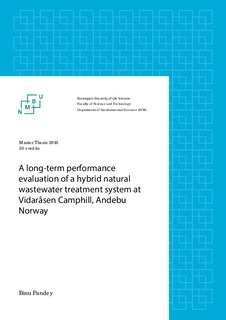| dc.description.abstract | Treatment systems like constructed wetlands and ponds have been successfully applied in Natural the treatment of domestic wastewater both in warm and cold climate. If well operated and maintained these systems perform well and produce a consistent effluent quality that meets the local permit requirements. This study examines long-term performance data of Vidaråsen wastewater treatment system in Vidaråsen Camphill in Andebu municipality in Norway. Founded in 1966, Vidaråsen Camphill is a first Camphill village in Norway. Vidaråsen is a small community comprising around 200 people. The community includes a dairy, a food-processing workshop, a bakery, a laundry, animal husbandry, horticulture and a herb garden. The Camphill village has its own wastewater treatment system since transport of wastewater to the nearest municipal system would be very expensive. Before 1998, Vidaråsen Camphill had wastewater treatment consisting of chemical precipitation of phosphorus (P) followed by biological treatment in a pond system. However, because of the high operating cost of the chemical treatment and low reuse value of the chemically precipitated sludge, an entirely new fully nature based treatment system was built in September 1998. The new system utilizes the combination of ponds and horizontal and vertical flow constructed wetlands. The system had test plant status until January 2002 and had to meet the stringent effluent P requirement of 0.4 mg/l and a total organic carbon (TOC) requirement of 10 mg/l. The system consists of following sequence of treatment units: primary settling tank (septic tank) → two pre-filters (vertical and horizontal flow constructed wetland) → advanced facultative pond (AFP) → three stabilization ponds→and two horizontal flow constructed wetlands.
The pre-filters, which are configured in series, are filled with shell sand, which has high P adsorption capacity in comparison to normal sand. The main feature of the AFP is that it has a distinct aerobic and anaerobic zone. The AFP is equipped with flow forms (cascade aeration), which helps to maintain the high level of dissolved oxygen concentration in the upper layer of the pond for enhancement of aerobic degradation. The deep center pit of the AFP is particularly designed to promote anaerobic degradation and thus low sludge production. The AFP is followed by the three stabilization ponds in series. The pond effluent finally passes through two horizontal flow (HF) beds. The horizontal flow constructed wetlands (CW) are filled with shell sand.
This study evaluates the performance of the Vidaråsen system for suspended solid (SS), biochemical oxygen demand (BOD), chemical oxygen demand (COD), total nitrogen (TN), total phosphorus (TP) and Thermotolerant Coliforms (TtC) from 2004 to 2014. The samples were collected several times a year both in warm and cold months. The grab samples from the influent (outlet of the septic tank), final effluent (outlet of HF constructed wetland) are analyzed for BOD, COD and TP. SS, and TtC is analyzed only for the final effluent. Influent and effluent from each treatment stages were analyzed only for TP. The average yearly performance data shows that the Vidaråsen system was capable to meet the effluent permit requirement for all the parameters. The average yearly effluent concentration for SS, BOD, COD, TN, and TTC was 98%, 99%, 95%, 89% and 99.9% respectively. This high degree of removal efficiency is difficult to achieve by stand-alone CW or pond system. Analysis of seasonal performance for nitrogen shows that the effluent concentration increased in colder months. The frequency distribution of outlet phosphorus showed that the system produced outlet phosphorus concentration below 0.4mg/l 75% of the time during sampling. The final outlet total coliform met both the European and Norwegian requirement for a bathing water quality. The per capita area requirement is 11 m2 which is higher than the compact filter bed used in Norway. The evaluation of treatment performance from this study as well as from the earlier study shows that even without the ponds number 2 and 3 the system is able to meet the permit requirement. Therefore the optimization of land area should be given due consideration if such systems is to be replicated elsewhere. | nb_NO |
